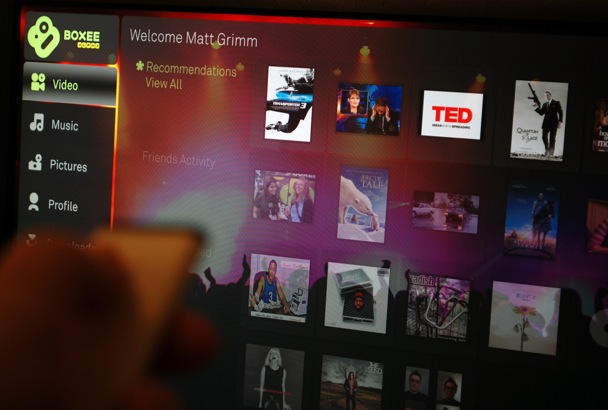The popular Boxee media center software is the rare app that starts on the Mac before going to Windows. CC-licensed pic by Matt Grimm.
Here’s some good news for Mac users of Boxee, the popular media platform for Macs and Apple TV: The software is going Windows.
At a developer event on Tuesday night in San Francisco, Boxee released its first version for Windows PCs.
This is good news for Mac users because the Boxee platform will have a much larger user base for developers to create plug-ins for. Significantly, the software will run on Windows Media Center PCs, which is by far the biggest installed base of computers connected to TVs.
Boxee is free software for playing movies, TV shows, music and photos, either from the users personal collection, or streamed from the Web.
Boxee was launched on the Mac (and Linux) in early 2007. It is one of those rare pieces of software that launched on the Mac first before moving to Windows. In most cases, the migration between platforms is the other way around.
“We’re all Mac users,” explained Avner Ronen, Boxee’s founder and CEO, speaking by phone from New York recently. “The Mac is a lot of early adopters. It’s a savvy audience, people like us.”
Since then, Boxee has grown fast, thanks mostly to its open architecture.
Unlike the Apple TV and Apple’s Front Row software, Boxee is an open platform. It allows developers to add plug-ins for content anywhere on the Web, from the Weather Channel to the adult-oriented BoXXXee.
Ronen said the company is hoping for 1 million Boxee users by the end of the year –œ most of the new users coming from Windows –œ and a slew of new plug-ins. At Tuesday’s developercmeetup, Boxee announced new plug-ins for MLB.tv, Digg, Tumblr and Current TV.
Boxee now boasts more than 500,000 users, most on the Mac. About 100,000 users run Boxee on an Apple TV; 50,000 users are on Linux; and the remainder are on Mac minis or Mac laptops, most connected to HDTVs.
“Running on a Mac Mini is the most popular setup,” said Ronen.
Based in New York, Boxee got a lot of notice earlier this year when the streaming TV site Hulu blocked it. (Hulu is once again available on Boxee courtesy of a RSS hack).
“It’s a shame. We should be allies,” said Ronen. “We have similar vision.”
The vision is getting Web media on TV with easy-to-use software, Ronen said, that’s wide open for developers to innovate on.
“The goal is to be the Firefox for the living room,” he said. “Boxee could be the first meaningful platform for the living room to be completely open. No gatekeepers or committees or convincing people at big companies that your ideas have merit.”
Launching on the Mac first was a great move, Ronen explained.
“The Mac is a great playground,” he said. “We’ve learned a lot of lessons on the Mac, and a lot of these lessons will be implemented on Windows. Mac users are very friendly. We got great feedback.”

Leander Kahney is the editor and publisher of Cult of Mac.
Leander is a longtime technology reporter and the author of six acclaimed books about Apple, including two New York Times bestsellers: Jony Ive: The Genius Behind Apple’s Greatest Products and Inside Steve’s Brain, a biography of Steve Jobs.
He’s also written a top-selling biography of Apple CEO Tim Cook and authored Cult of Mac and Cult of iPod, which both won prestigious design awards. Most recently, he was co-author of Cult of Mac, 2nd Edition.
Leander has been reporting about Apple and technology for nearly 30 years.
Before founding Cult of Mac as an independent publication, Leander was news editor at Wired.com, where he was responsible for the day-to-day running of the Wired.com website. He headed up a team of six section editors, a dozen reporters and a large pool of freelancers. Together the team produced a daily digest of stories about the impact of science and technology, and won several awards, including several Webby Awards, 2X Knight-Batten Awards for Innovation in Journalism and the 2010 MIN (Magazine Industry Newsletter) award for best blog, among others.
Before being promoted to news editor, Leander was Wired.com’s senior reporter, primarily covering Apple. During that time, Leander published a ton of scoops, including the first in-depth report about the development of the iPod. Leander attended almost every keynote speech and special product launch presented by Steve Jobs, including the historic launches of the iPhone and iPad. He also reported from almost every Macworld Expo in the late ’90s and early ‘2000s, including, sadly, the last shows in Boston, San Francisco and Tokyo. His reporting for Wired.com formed the basis of the first Cult of Mac book, and subsequently this website.
Before joining Wired, Leander was a senior reporter at the legendary MacWeek, the storied and long-running weekly that documented Apple and its community in the 1980s and ’90s.
Leander has written for Wired magazine (including the Issue 16.04 cover story about Steve Jobs’ leadership at Apple, entitled Evil/Genius), Scientific American, The Guardian, The Observer, The San Francisco Chronicle and many other publications.
Leander is an expert on:
Apple and Apple history
Steve Jobs, Jony Ive, Tim Cook and Apple leadership
Apple community
iPhone and iOS
iPad and iPadOS
Mac and macOS
Apple Watch and watchOS
Apple TV and tvOS
AirPods
Leander has a postgrad diploma in artificial intelligence from the University of Aberdeen, and a BSc (Hons) in experimental psychology from the University of Sussex.
He has a diploma in journalism from the UK’s National Council for the Training of Journalists.
Leander lives in San Francisco, California, and is married with four children. He’s an avid biker and has ridden in many long-distance bike events, including California’s legendary Death Ride.
You can find out more about Leander on LinkedIn and Facebook. You can follow him on X at @lkahney or Instagram.


